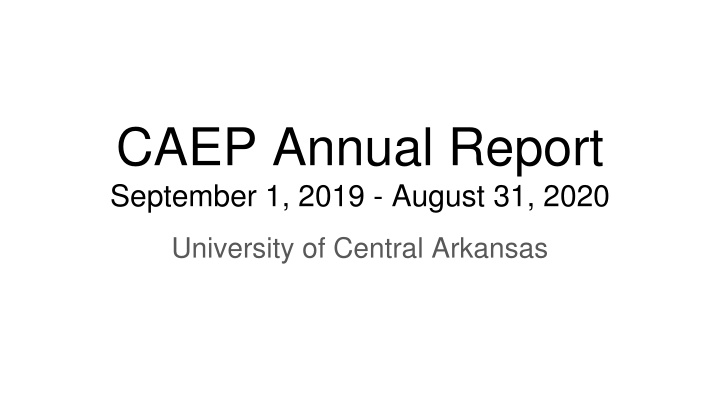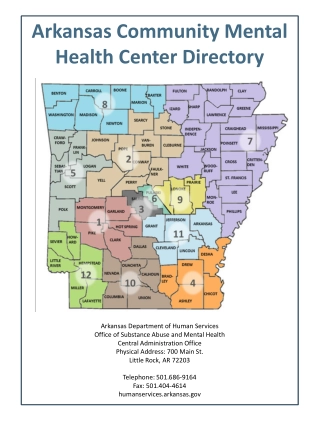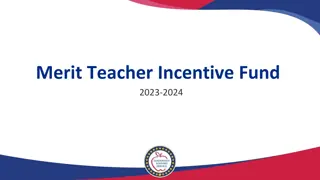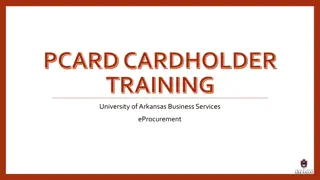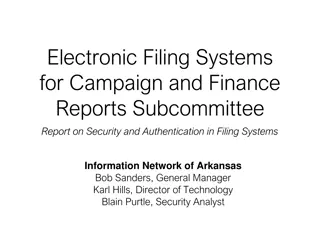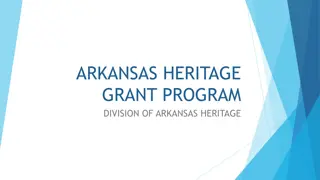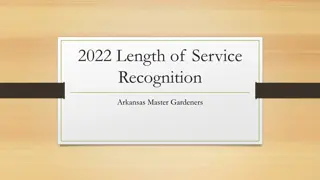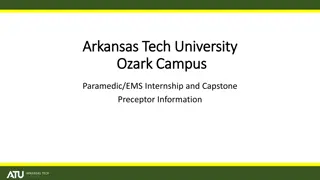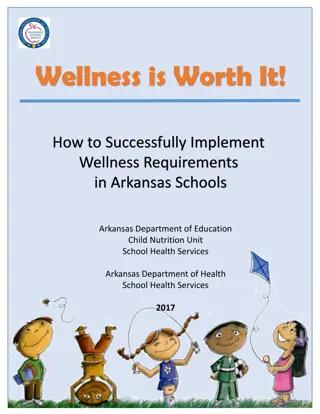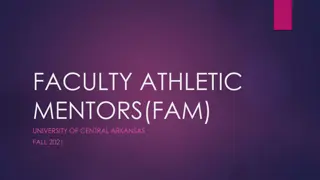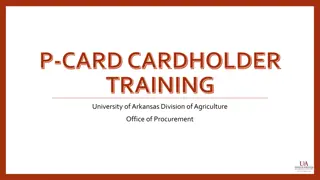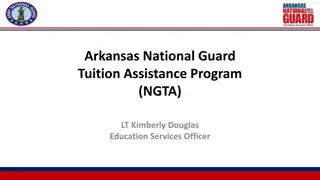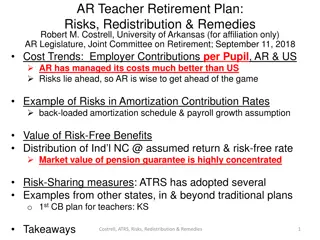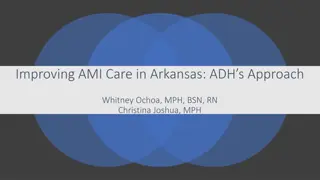Annual Report Summary - University of Central Arkansas
The annual report summary for the University of Central Arkansas covers the Council for the Accreditation of Educator Preparation (CAEP) annual reporting measures, program completer data, initial and advanced programs details, and the impact of completers on P-12 learning. Explore key metrics and outcomes within the education programs at UCA during the academic years 2017-2018 to 2019-2020.
Download Presentation

Please find below an Image/Link to download the presentation.
The content on the website is provided AS IS for your information and personal use only. It may not be sold, licensed, or shared on other websites without obtaining consent from the author.If you encounter any issues during the download, it is possible that the publisher has removed the file from their server.
You are allowed to download the files provided on this website for personal or commercial use, subject to the condition that they are used lawfully. All files are the property of their respective owners.
The content on the website is provided AS IS for your information and personal use only. It may not be sold, licensed, or shared on other websites without obtaining consent from the author.
E N D
Presentation Transcript
CAEP Annual Report September 1, 2019 - August 31, 2020 University of Central Arkansas
Overview CAEP (Council for the Accreditation of Educator Preparation) has eight annual reporting measures which are used to provide information to the public on both program outcome and program impact. These annual reporting measures are expected for both initial and advanced programs. These data are for the UCA COE in alignment with CAEP annual reporting expectations.
8 Annual Reporting Measures 1. Measure 1: Impact completers teaching has on P-12 student learning and development 2. Measure 2: Indicators of completers teaching effectiveness 3. Measure 3: Results of employer surveys including retention and employment milestones 4. Measure 4: Results of completer surveys 5. Measure 5: Completer graduation rates including rates for successful completion of student teaching by program areas 6. Measure 6: Ability of completers to meet licensing / certification requirements 7. Measure 7: Ability of completers to be hired in education positions for which they are prepared 8. Measure 8: Student loan default rates and other consumer information
Program Completer Data Academic Year Initial Advanced Programs Combined UG and MAT 2019-2020 257 124 2018-2019 237 234 2017-2018 256 224
INITIAL PROGRAMS 2017-2018 2018-2019 2019-2020 K-6 Elementary 87 76 96 4-8 Middle Level 53 46 21 4-12 Business 2 2 1 7-12 English 14 12 9 7-12 FACS 12 12 10 7-12 Life Science 12 5 11 7-12 Math 14 10 9 7-12 Physical Science 1 6 3 7-12 Social Studies 10 8 9 7-12 Speech / Drama 0 2 2 K-12 Art 7 8 9 K-12 Music 9 12 19 K-12 PE/Health 14 17 25 K-12 Spanish 3 3 2
ADVANCED PROGRAMS 2017-2018 2018-2019 2019-2020 Building Level Admin 28 36 12 District Level Admin 7 4 1 Curriculum Specialist 7 6 3 Program Specialist - SPED 3 5 0 Library Media 55 47 22 Reading 3 4 5 Dyslexia 6 10 9 Reading + Dyslexia 20 13 11 School Counseling 62 62 37 Gifted 11 15 5 B-K 5 6 4 Special Education 17 18 11 Special Education Resource 0 8 4 TOTAL 224 234 124
Measure 1: Completers Impact on P-12 Learning Arch Ford Novice Teacher Partnership - Impact on Student Learning
Measure 1: Completers Impact on P-12 Learning (AF) Data presented here were secured through partnership with Arch Ford (AF) Novice Teacher (NT) Mentoring Program begun in summer 2017. The AFNT program supports UCA graduates in induction for 3-years post graduation. Districts in the AFNT region support 30% of UCA prepared teacher candidates representing all programs across the EPP. All novice teachers in the AFNT program complete an Impact on Student Learning project each March and report data to AF. Data for UCA prepared teachers is compared to the AF aggregate as a benchmark. In 2019-2020, K-12 students taught be UCA completes appeared to be making slightly lower gains in their learning when compared to the aggregate benchmark data. The UCA aggregate population scaled score gain x = 14.31 compared to the AF aggregate gain of x = 16.30. Similarly, the GPA gain for the UCA aggregate was x = 1.44 compared to the AF GPA aggregate gain of x = 1.65. This represents an anomaly in the data given trends in the previous two years. UCA will continue to monitor data, but given that spring 2020 saw the advent of the COVID-19 school shut-downs, data may be affected by that event. Certainly only half of the UCA prepared completers (e.g., 51 of an anticipated 101) were able to submit their scores as this requirement occurs in March, the same month of the state-side school shutdowns. Data disaggregated by program - LINK HERE Note: Initial Programs Only
Measure 1: Completers Impact on P-12 Learning Note: Initial Programs Only
Measure 2: Completers Teaching Effectiveness Arch Ford Novice Teacher Partnership - Mentor Teacher Ratings
Measure 2: Completers Teaching Effectiveness (AF) Data presented here were secured through partnership with Arch Ford (AF) Novice Teacher (NT) Mentoring Program begun in summer 2017. The AFNT program supports UCA graduates in induction for 3-years post graduation. Districts in the AFNT region support 30% of UCA prepared teacher candidates representing all programs across the EPP. All novice teachers in the AFNT program are observed by their mentor teacher and scored on the state-mandated performance observation rubric (Danielson, 2007). Data for UCA prepared teachers is compared to the AF aggregate as a benchmark. In AY 2019-2020 trends noted earlier continued with strengths noted in domain 4 as well as in 1b: knowledge of students (x =3.18), 2a: respect and rapport (x =3.11), 3a: communication (x =3.19), and 3e: flexibility (x = 3.14). Relative low points were noted in 2d: managing student behavior (x =2.69), and 3d using assessment (x =2.66). The EPP feels the work of the summer 2020 ad hoc working groups is critical to continued discussion of these low points and is optimistic the actions taken by these groups will lead to increased scores in these areas in the next 1-3 years. Data disaggregated by program - LINK HERE Note: Initial Programs Only
Measure 3: Employer Satisfaction and Milestones UCA Employer Survey - Initial Programs UCA Employer Survey - Advanced Programs
Measure 3: Employer Satisfaction and Milestones (initial) UCA measures employer satisfaction of program completers through multiple measures including a UCA survey, Arch Ford partner employee survey, and ADE/DESE measure of employer satisfaction. The data presented here were collected through a UCA principal survey aligned to the expectations of the Interstate Teacher Assessment and Support Consortium (InTASC) standards. All data included in the data set were scored on a scale of 1-4 (1 = not prepared, 2 = inadequately prepared, 3 = adequately prepared, 4 = well prepared) with a target score of 3. Overall trends in Spring 2020 indicate that the EPP is doing well in preparing candidates to for the field with all scores falling in the upper range of the survey (levels 3-4). Relative high points in the data include candidate knowledge of content (x = 3.54, 3.55, 3.58), use of instructional technology (x = 3.57, 3.60, 3.66), planning and preparation (x = 3.51, 3.55, 3.59), instruction (x = 3.46, 3.52, 3.58), and professional responsibilities (x = 3.50, 3.49, 3.64). Relative low points in the data were ability to work with students with special needs (x = 3.18, 3.37, 3.46), managing student behavior (x =3.11, 3.20, 3.39), and parent / family communication (x = 3.30, 3.25, 3.43). Faculty in the CAEP Standard 4 committee noted a trend up over the three semesters in the data except for professional responsibilities (already a strong point) and for parent/ family communication. Disaggregated and trend data on employer satisfaction by program available in supplemental document - LINK HERE. Disaggregated and trend data on completer employment milestones by program available in supplemental document - LINK HERE
Measure 3: Employment Retention and Milestones (initial) EPP gathers data on advanced program completers employment and retention milestones in partnership with UCA Office of Institutional Research and in partnership with DESE. Approximately 60-65% of UCA completers work in Arkansas Public Schools post-graduation. Approximately 55% of completers working in APS work in identified high-needs schools in their first year of induction. 97-100% of completers teaching in Arch Ford partner school districts intend to remain in the profession Approximately 20% of graduates return to graduate school to pursue advanced degrees 3-years post-graduation. Spring 2019 Spring 2020 Spring 2018 Completers currently teaching in APS 60% 63% 64% % intent to remain in profession 100 98.78 97 % enrolled in graduate school 29.84 17.25 * % teaching in high needs schools (grades C-F) * 47.97% 54.65%
Measure 3: Employer Satisfaction and Milestones (advanced) The data presented here were collected through an employer survey aligned to the expectations of the Council for the Accreditation of Educator Preparation (CAEP) (Standard A.1.1). All data included in the data set were scored on a scale of 1-4 (1 = not prepared, 2 = inadequately prepared, 3 = adequately prepared, 4 = well prepared) with a target score of 3. This practice was re-established in spring 2018 yielding 2-years data (Spring 2018, Spring 2019). Relative high points in the data in spring 2020 included employer ratings around completer skills and content specific to the professional role (x = 3.85, 3.64, 3.82) and ability to integrate technology into professional practice (x = 3.85, 3.64, 3.82). Consistently lower points in the data included understand/use research to support professional role (x = 3.54, 3.64, .76) and professional dispositions (x = 3.85, 3.4, 3.68). Again, while these data points are the relative low spots in the data, all far exceed the benchmark and lie near the well prepared indicator. Disaggregated employer satisfaction data by program available in supplemental document - LINK HERE. Disaggregated data on completer employment milestones by program available in supplemental document - LINK HERE.
Measure 3: Employment Retention and Milestones (advanced) EPP gathers data on advanced program completers employment and retention milestones in partnership with UCA Office of Institutional Research 2017-2018 2018-2019 2019-2020 68% 67% 66% Completers currently holding a position in APS aligned with advanced degree obtained
Measure 4: Graduate Satisfaction Graduate Satisfaction Survey - Advanced Programs Graduate Satisfaction Survey - Initial Programs
Measure 4: Graduate Satisfaction (initial) UCA measures employer satisfaction of program completers through multiple measures including UCA survey, Arch Ford partner novice teacher survey, and ADE/DESE measure of graduate satisfaction. The data presented here were collected through a UCA post-graduate satisfaction survey aligned to the expectations of the Interstate Teacher Assessment and Support Consortium (InTASC) standards. All data included in the data set were scored on a scale of 1-5 (1 = not prepared, 2 = inadequately prepared, 3 = adequately prepared, 4 = well prepared, 5 = very well prepared) with a target score of 3. Spring 2020 trends noted in the three data cycles highlighted candidate strengths including lesson planning (x = 4.13) with additional high points in the data noted as content knowledge preparation (x = 4.18) and instructional strategies (x = 4.11). Relative low points in the data continued to include managing student behavior (x = 3.42), professional learning (x =3.75), and consideration of diversity (x = 3.75). While all data were positive and ranged predominantly in the well prepared and very well prepared categories, faculty noted some noted areas of adequately prepared differences across programs. Data will be used with programs to seek continuous improvement. Disaggregated and trend data by program available in supplemental document - LINK HERE
Measure 4: Graduate Satisfaction (advanced) The data presented here were collected through a post-graduate satisfaction survey aligned to the expectations of the Council for the Accreditation of Educator Preparation (CAEP) (Standard A.1.1). All data included in the data set were scored on a scale of 1-5 (1 = not prepared, 2 = inadequately prepared, 3 = adequately prepared, 4 = well prepared, 5 = very well prepared) with a target score of 3. Spring 2020 trends were consistent with previous years with high points noted for instructor ability to model best practices (x =3.74) and candidates rating of their preparation in the area of collaboration (x =3.79), preparation in professional disposition/ethics (x = 3.65) and content/skills necessary for new role (x =3.65). Relative low points were noted for research (x =3.43) and data literacy (x =3.52), but the mean was still at the top of the provided range. Within programs data were uniformly strong with the EDLP and SCCN programs showing more data points above the UCA benchmark and LIBM, RDNG, GATE, and SPED showing data below the UCA benchmark. SLMA had a mix of data above and below the benchmark. There are some inconsistencies with the previous years data which indicated LIBM and RDNG had stronger scores than the benchmark programs; however, consistent in the data were the lower scored for the SPED and GATE programs. It should be noted that both SPED and GATE are graduate certificate programs (not MSE programs), and this may be affecting some of the scoring. Program coordinators will continue to parse the data in the fall 2020 term. Disaggregated and trend data by program available in supplemental document - LINK HERE. Note survey was significantly revised in spring 2019 with expanded items and revised scale.
Measure 5: Completer Graduation Rates Retention and Completion of Student Teaching - Initial Programs Retention and Graduation Rate Data - Advanced Programs
Measure 5: Completer Graduation Rates (initial) Initial program retention is tracked across programs from admission through graduation and licensure by the Office of Candidate Services (IR). Data indicate that >90% of initial candidates entering internship complete and apply for their teaching license. Focus group and interview data indicate that the majority of those candidates who choose to not license do so after experiencing the internship semester and gaining a deeper understanding of the demands of the profession. Advanced programs report an 89.09% retention rate for first year of enrollment in candidates programs of study. Access to full reports - LINK HERE (initial); LINK HERE (advanced)
Data: MAT Program. Source and Disaggregated Data - LINK HERE
Measure 5: Completer Graduation Rates (advanced) Advanced candidates are tracked by program coordinators and UCA Office of Institutional Research. IR provides fall only snapshot data as representative data. Advanced programs report a 79% retention rate for five year of enrollment in candidates programs of study. Access to full reports - LINK HERE (initial); LINK HERE (advanced)
Data: UCA Office of Institutional Research. Source and Disaggregated Data - LINK HERE
Measure 6: Ability of Completers to Meet Requirements Praxis Data - Initial Programs Praxis Data - Advanced Programs
Measure 6: Ability of Completers to Meet Requirements Candidate pass rate on required content Praxis exams is tracked across programs by the Office of Candidate Services (OCS). Disaggregated program data are tracked for pass rates, mean score, standard deviation, and range Both initial and advanced programs report overall success in candidate ability to pass the required Praxis content exam(s) with many programs yielding pass rates at 90% and higher. Access to full reports - LINK HERE (initial); LINK HERE (advanced)
Data: OCS. Source and Disaggregated Data - LINK HERE (initial); LINK HERE (advanced)
INITIAL UNDERGRADUATE PROGRAMS # Taking # Passing Program Pass Rate State Pass Rate 81 76 94 97 K-6 Elementary: Reading and Language Arts 81 75 93 96 K-6 Elementary: Mathematics 81 62 77 87 K-6 Elementary: Social Studies 81 67 83 89 K-6 Elementary: Science 9 6 67 65 4-8 Middle Level: English Language Arts 6 5 83 81 4-8 Middle Level: Math 6 5 83 77 4-8 Middle Level: Science 8 8 100 90 4-8 Middle Level: Social Studies 7 6 86 93 7-12 English 10 9 90 94 7-12 FACS 6 6 100 94 7-12 Life Science 6 4 67 70 7-12 Math 1 * * * 7-12 Physical Science
INITIAL MAT PROGRAMS # Taking # Passing Program Pass Rate State Pass Rate 14 14 100 99 K-6 Elementary: Reading and Language Arts 14 14 100 100 K-6 Elementary: Mathematics 14 14 100 97 K-6 Elementary: Social Studies 14 14 100 99 K-6 Elementary: Science 4 * * 78 4-8 Middle Level: English Language Arts 2 * * 76 4-8 Middle Level: Math * * * 79 4-8 Middle Level: Science 4 * * 93 4-8 Middle Level: Social Studies 1 * * 100 4-12 Business 1 * * * 7-12 Drama 2 * * 92 7-12 English 5 5 100 100 7-12 Life Science 3 * * 83 7-12 Math 1 * * * 7-12 Physical Science 1 * * 79 7-12 Social Studies 1 * * * 7-12 Speech
ADVANCED PROGRAMS # Taking # Passing Program Pass Rate State Pass Rate 11 10 90.91 96.01 Building Level Administrator (6990) 1 * * * District Level Administrator (6991) 21 20 95.24 94.44 Library Media (5311) 19 17 89.47 92.77 Reading (5301) 27 26 96.3 93.75 School Counseling (5421) 6 5 83.33 84.82 Gifted (5358) 4 * * 93.55 B-K (5023) 1 * * 52.63 B-K (5024) 18 18 100 92.45 Special Education (5354) 22 22 100 86.02 Special Education (5511) 4 4 100 86.02 Special Education Resource (5354)
Measure 7: Ability of Completers to be Hired ADE Data - Initial Programs Employment Milestones - Advanced Programs
Measure 7: Ability of Completers to be Hired (initial) EPP gathers data on initial program completers employment and retention milestones in partnership with UCA Office of Institutional Research and in partnership with Arkansas Division of Elementary and Secondary Education. Approximately 55% of completers working in Arkansas Public Schools work in identified high-needs schools in their first year of induction. The average letter grade for these schools is C . These schools serve a mean 47.1% students of color, 64.75% students identified as low income, schools with 15.53% SPED population, and schools with 6.57% English Language Learners. Spring 2019 Spring 2020 Spring 2018 Completers currently teaching in Arkansas Public Schools 60% 63% 64%
Measure 7: Ability of Completers to be Hired (advanced) EPP gathers data on advanced program completers employment and retention milestones in partnership with UCA Office of Institutional Research 2018-2019 2019-2020 2017-2018 68% 67% 66% Completers currently holding a position in Arkansas Public Schools aligned with advanced degree obtained
Measure 8: Student Loan Default Rates University-wide rate of default on student loans for the years 2013, 2014 and 2015, based on data provided by the Office of Federal Student Aid. This rate is provided to UCA by the USDE and reported to HLC each year. UCA OPE ID School School Type Control Programs FY 2017 FY 2016 FY 2015 00109200 Univ. of Central Arkansa s Public Both (FFEL/FDL) Default Rate 8.5 7.5 8.1 Master s Degree or Doctor s Degree No. in Default 231 208 228 No. in Repay 2,706 2,750 2,796 Enrollment Figures 13,553 13,466 13,255 Percentage Calculation 19.9 20.4 21 Source: https://www2.ed.gov/offices/OSFAP/defaultmanagement/cdr.html
Measure 8: Additional Consumer Information Federal School Code 001092 Number of Undergraduate Students 8,615 In-State Tuition $9,338 Number of Graduate Students 1,720 Out-of-State Tuition $16,148 ACT Average (1-36) 24.2 Average Net Yearly Cost after Financial Aid $14,055 GPA Average 3.59 Graduation Rate 43.0% % of Students Receiving Loans 47% 1st Year Retention Rate 78.8% Acceptance Rate 90.4% Average Monthly Loan Payment 221 Sources: https://uca.edu/studentaccounts/tuition-and-fee-rates/ https://datausa.io/profile/university/university-of-central-arkansas/#intro https://uca.edu/ir/files/2019/03/Diversity-Ledger-2017.pdf https://uca.edu/news/uca-announces-preliminary-fall-2020-enrollment-breaks- record-for-student-retention/ https://uca.edu/ir/facts-and-figures/bear-facts/ https://uca.edu/education/caep/#StudentLoanDefaultRatesInitial Salary After Attending 36,900
